Moving on, by breaking the system into a quantity of incremental builds, the clients and stakeholders can manually evaluate the system’s earlier versions faster than possible with a waterfall mannequin or most other growth processes. Thus, allowing the stakeholders to discover out if their necessities are being met. So, this helps the developer to obtain consumer and customer suggestions on the system and progress made. Thus, it’s a more sensible analysis method the place the shoppers can obtain a sensible utilisation of the system. Incremental improvement in software program engineering is a process methodology that emphasizes the advantage of taking small steps toward the goal.

Since the plan simply considers the subsequent increment, there aren’t actually any long-term plans throughout this period. Iterative growth implies revisiting usual waterfall mannequin steps over the course of product lifetime. The levels can even overlap, i.e. while doing end-to-end testing you would already start preparing new necessities. Based on the feedback received, the development staff proceeds to develop subsequent increments, every of which adds new performance to the software program. The increments are developed in priority order, specializing in delivering probably the most valuable options first.
Iterative Improvement Steps
Padgett (1980) created a mannequin of federal budgeting that continued to make use of the BR notion of heuristic search but which implied that allocations will sometimes be nonincremental. In the world of innovation, where there are plenty of unknowns, each from a product perspective and a technology perspective, iterative/incremental course of improvement can come to the rescue. Communicating with prospects and different stakeholders after every brief improvement cycle allows a steady flow of feedback and collaboration, bringing important insights into what’s working and what’s not in your product.
- Iterative requirement prioritisation helps in RCM by comparing the need for the change with the existing necessities after which placing it an acceptable priority location for implementation.
- Agile improvement, totally different to conventional software program improvement encourages change in every iteration.
- You don’t at all times have the answers, so you must make assumptions to make selections, whether they work out or not.
- Based on this feedback, it helps the developer to evolve the software via a number of variations.
Think of iterations as shorter improvement and testing cycles applied to at least one a half of the product, or a bare-bones model of a product, before enhancing the product by building further options. Iterative and incremental growth is any combination of each iterative design or iterative method and incremental construct model for improvement. Therefore, this incremental model is more appropriate for a system where the requirements are clear and could be implemented in phases. Hence, this makes it a limitation for methods the place the necessities and incremental parts are unclear. However, this could be avoided via thorough preliminary analysis and planning. Additionally, this makes it clear that an incremental model is generally extra appropriate for smaller-scale techniques with a well-defined and easy scope.
The incremental model was originally developed to observe the normal assembly line model used in factories. Unfortunately, software design and growth has little in frequent with manufacturing physical goods. Locking the builders right into a set of assumptions with out the proper context may lead to poor designs in the best case or a whole derailing of the event in the worst.
Some essential and efficiently executed software program projects like Google Chrome and Mozilla Firefox are nice examples of both iterative and incremental software program improvement. So you’re asking about the difference between incremental and iterative approaches to software development, but your quote seems at iterative design, which is a unique factor (although similar). Iterative development is much less involved with tracking the progress of individual options.
Incremental Mannequin
The first profit or purpose the incremental growth model is employed is so that shoppers can get hold of value and evaluate or check techniques earlier within the growth process. Especially with an agile technique, an incremental method permits partial utilisation of the system, so we will avoid an extensive growth time. Thus, the developers can start permitting access to the product with limited functionalities, which is especially helpful for testing functions.
2D projections together with a slider concept much like the one described by Burger et al. (2014) to filter information is useful to identify tendencies. The incremental and iterative development course incremental development model of may be difficult, however is actually satisfying when done right. Customers often ask for brand new issues to be added to future growth cycles.
This can give you a strong advantage over rivals because you’re leveraging virtually real-time information to make your product extra robust. Parallel Development Model – Different subsystems are developed on the similar time. Consumers experience the products and create new specifications which would possibly be rigorous prioritization right down to fewer workdays. This identifies that the answer may be considered to have a variety of architectural layers. The below determine used right here relates to a business system growth but the concept may additionally be utilized to a non-IT project, such as a advertising marketing campaign.
However, each of these software growth processes differs by method of the order of those steps and their construction. The waterfall mannequin and the incremental mannequin are probably the most commonly utilized improvement fashions used to improve tracking and develop functions. The waterfall model is a linear, sequential process the place each part of development must be completed before the next part can begin. It’s called a “waterfall” mannequin as a outcome of the development course of flows downward in a linear fashion like a waterfall. When making a software product, there are a variety of software growth models—waterfall, Agile, incremental, RAD, iterative, spiral, and so forth.—to take into account.
Role-based Advert Hoc Teamwork
While some clustering strategies may be very gradual, tools like CHUNK run in near-linear time. Throughout this chapter, we evaluate models based on how typically they lead an ad hoc agent to make the “correct” determination about which function to assume. If the margin is not statistically significant, then the choice just isn’t counted as appropriate https://www.globalcloudteam.com/ or incorrect. We decide statistical significance by running a two-tailed student’s t-test assuming two-sample unequal variance. The validity range of the data-driven mannequin is described based mostly on convex hulls (see e.g. Kahrs and Marquardt, 2008) and on statistical indicators just like the prediction error. In our work, inputs are normalized and a perform describing the gap of the middle is generated.

The first step is to assemble the preliminary set of requirements for the software. This entails understanding the wants and expectations of the stakeholders and customers, the development group works carefully with stakeholders to assemble and analyze necessities. Each stage entails completing an increment of the general software program improvement cycle and including it to the ultimate product. A diagram I saw explaining the Incremental model showed that the Needs analysis / Design / Implement parts had been iterated, however there was just one Deployment, after the final iteration. So the product got larger and better after each iteration, and went by way of its testing cycle together with UAT each time, however was not launched incrementally. This process is used for revisiting developed code constructions and modifying them to enhance structure and to accommodate change [86].
Examples Of Iterative Growth
Additionally, they should decide when and the way typically they’ll evaluation their project and report their progress. These reviews are an necessary alternative for teams to check their project and make changes where necessary. Teams must also benefit from project management tools and software program to help them observe their progress and handle their project successfully (e.g., Plutora VSM). To scale back the risks that the incremental model poses, groups ought to communicate effectively and set realistic expectations for each other. Each iteration passes by way of the necessities, design, coding and testing phases. And each subsequent release of the system adds perform to the earlier launch until all designed performance has been applied.
Agile tries to make use of “finest” strategies from numerous fields (e.g. excessive programming). Agile doesn’t exclude working neither incremental nor iterative development. Incremental software improvement is extra general, and refers to moving work forward in steps, which is a feature of most (perhaps all?) approaches. With that stated, the term is more typically used in relation to fashionable, agile approaches, which most likely explains the confusion between the 2 very similar phrases.

Then, we’ll examine this mannequin with the waterfall model in more element and discuss its benefits and drawbacks. Finally, we’ll look at examples of the incremental mannequin and learn how to implement it. The growth team can start by creating a minimum viable product (MVP) with essential options after which launch it to assemble consumer suggestions. Based on the suggestions, subsequent iterations can add new options, enhance performance, enhance user experience and handle any issues or bugs. Iterative software development aims to construct a working product as soon as potential, whereas repeatedly including and adapting new features based mostly on person suggestions. It concludes with the deployment of completed software program at the finish of every cycle.
The incremental course of mannequin is also identified as the Successive model model. Each of the phases may be divided into 1 or extra iterations, which are usually time-boxed quite than feature-boxed. Architects and analysts work one iteration ahead of builders and testers to maintain their work-product backlog full. In Chapter 15, we generate impact detect predictions by extrapolating between the identified effort/defect values seen of their two nearest prototypes. In that strategy, as quickly as the prototypes are generated, we can ignore the unique set of rows. If we limit the reasoning to simply these average effects, we can mitigate a few of the complicated results of noisy information.
The agile methodology centered on processes that had been more iterative and incremental in their approach, allowing you to acquire crucial info a lot faster and make higher selections. Therefore, this guide then goes into more detail explaining what precisely is the incremental improvement model in addition to its noteworthy advantages in software development. In distinction to the waterfall development model the place it only has a single delivery which is the ultimate system, for incremental development, as there are a quantity of increments, every increment has its personal deliverables. So, every increment delivers part of the required functionality, where the most important or urgently-needed necessities are incorporated first, especially consumer necessities. The incremental model is a software improvement methodology that can be utilized to build large and complex techniques. It’s based mostly on the idea of including new features, or “increments,” to an current system instead of building the complete thing from scratch directly.
